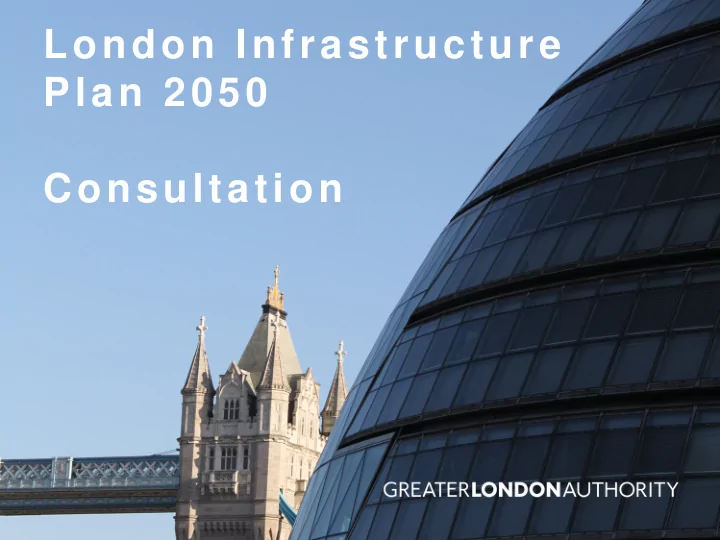

London Infrastructure Plan 2050 Consultation
AGENDA 1. CONTEXT 2. APPROACH 3. REQUIREMENTS 4. SPATIAL ASPECTS 5. BETTER DELIVERY 6. FUNDING 7. CONSULTATION
1. CONTEXT
AIMS Present recommendations and actions to ensure London’s infrastructure requirements to 2050 are articulated, costed and funding arrangements are in place (as far as possible). Demonstrate to the Government, Londoners and investors that infrastructure is a key priority and that London has a clear plan to meet the demands of its growing population and remain a leading world city. Ensure the Infrastructure Investment Plan is supported and deliverable, through active engagement of key stakeholders. Provide the Mayor and other London leaders with the information to understand and critically appraise London’s infrastructure delivery.
POLICY BACKGROUND London Finance Commission • 2020 Vision • London First Infrastructure Commission • London Housing Strategy • London Plan • Smart London Plan •
INFRASTRUCTURE IS VITAL
LONDON’S INFRASTRUCTURE IS A COMPETITIVE RISK.. Connectivity Aviation Congestion Housing Space for walking and cycling
…AND ITS POPULATION IS GROWING
MAJOR BENEFITS FROM MORE INFRASTRUCTURE INVESTMENT More jobs and growth • A better city to live in: • – Less congested, better connections across the transport system, safe and accessible to all – Being able to connect to the ‘internet of things’ from every corner of the city – Housing, schools and great communities for all – Reusing more materials to save money and the environment – Sustainable and affordable energy and water – More and better green space
2. APPROACH
FOUR CRITICAL QUESTIONS
3. REQUIREMENTS
OVERALL
TRANSPORT (1) Enable 36 trains per hour across Transform national the Jubilee, commuter rail network Piccadilly, through joint investment Northern and Central line with Network Rail (£15-20 bn) Tube investment £15-18 bn Crowding levels on the tube network 2031 Further ‘Crossrails’ starting with Crossrail 2 by 2030 Bakerloo and increasing line frequency of extension Crossrail 1 trains (£23-30 bn)
TRANSPORT (2) A series of new river crossings in east London to overcome the major barrier effect constraining the potential of this region (£1-2bn) A comprehensive network of high quality cycle and pedestrian routes (£2-4bn) A new inner orbital tooled tunnel and series of mini-tunnels and decking over to A congestion- help transform places busting programme across the city (£15- to support network 25bn) functioning for essential journeys (£2-5bn)
GREEN
DIGITAL CONNECTIVITY Before 2020s…and beyond Fibre and wireless access to the internet To enable new ideas
ENERGY More investment in locally produced energy (£300million in the pipeline)
WATER Sewage Expected a deficit in water supply of over half a billion litres a day by 2050 Flood defence About 16% of London is built on the protected flood plains of our rivers that holds critical infrastructure. More investment is needed in flood defences that can cope with climate changes and aging existing infrastructure defences.
4. SPATIAL ASPECTS
2. SPATIAL SCENARIOS Increasing densities in locations Assuming current policies continue with good public access. Increasing densities at town Accommodating population centres. outside London
5. BETTER DELIVERY
MAIN FINDINGS… Split governance across and within sectors Regulatory frameworks inhibiting developments, innovation and efficiencies Pace of innovation and technological change [other?]
INNOVATION AND TECH TO BE AT THE CORE OF OUR WORK Embrace Hardwiring existing and innovation new (through technologies projects such (such as BIM) as Crossrail) Open to radical change (with projects such as solar roads)
GOVERNANCE • A new Infrastructure Delivery Group • Work to gain cross party support and commitment to London’s infrastructure projects • Reforms to the regulatory systems (energy, water and ICT) to enable delivery ahead of demand • Fiscal devolution • Welcome further suggestions
6. FUNDING
COSTS
PAYING FOR IT
7. CONSULTATION
CONSULTATION / NEXT STEPS Autumn • Meetings with key stakeholders a • Structured workshops on specific themes Winter/Spring • Drafting of final report
KEY CONSULTATION QS 1. Rationale for having a plan? 2. Requirements? Any unnecessary? Anything else? 3. Funding – how to meet the gap? 4. What more in addition to the Delivery Board to ensure best practice joined up delivery? 5. Where will London’s growth best be accommodated? 6. Amend incentives for utility providers to share costs more equitably? How to do this? 7. Approach to technological change? Which innovations? 8. How to change behaviours to reduce demand? Sector specific questions
HELP US SHAPE THE REPORT Email: infrastructureplan@london.gov.uk Or on line response form at www.london.gov.uk/infrastructure Deadline for responses – 31 October 2014 Preferably no more than 2,000 words
Recommend
More recommend